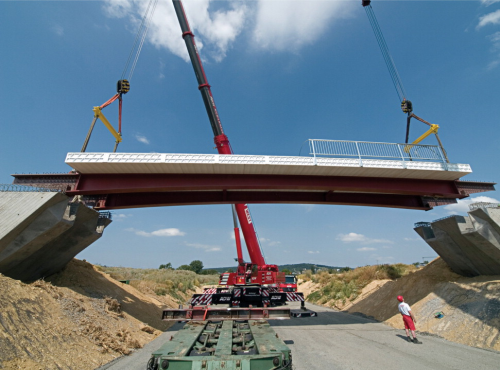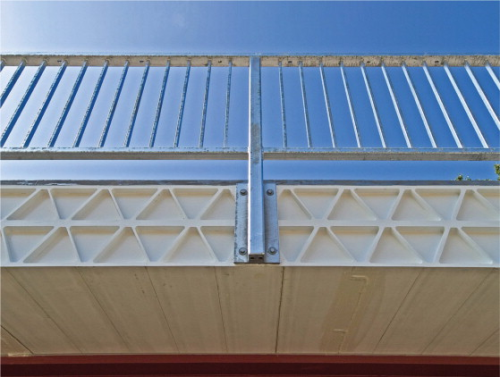

A glass reinforced plastic (GRP) bridge was constructed over the new German B3 highway at Friedberg, near Frankfurt, in July. The bridge was supplied complete from the factory and then lifted into position with the minimum of disruption to road traffic.
The 27 m long bridge is in fact a composite-steel hybrid structure, comprising a GRP deck adhesively bonded to two steel beams. The deck is made up of ASSET triangular, hollow-section pultruded profiles, manufactured by Fiberline Composites of Denmark. The superstructure is fixed to both abutments.
The ASSET profile is the result of a four-year, €4 million project, which started in 1998 and was partially-funded by the European Union (EU). ASSET is an acronym for Advanced Structural SystEms for Tomorrow's Infrastructure, and one of the project's aims was to find new and more durable construction materials for road bridges. Fiberline Composites was a member of the ASSET project; other partners included construction group Skanska and engineering company Mouchel.
The first stage of ASSET developed a prismatic profile for an FRP structural component of sufficient strength to carry heavy loads. It has a cross-section with triangular rather than hexagonal cells. The design was then worked up into an economical manufacturing process suitable for accurate mass production. The profiles can be used for bridge decking and structural reinforcement.
The first visible result of this project was Europe's first GRP road bridge. The 10 m span, 6.8 m wide West Mill bridge near Shrivenham in Oxfordshire, UK, opened in 2002. Before being officially opened to traffic the bridge, which was designed to be able to carry 40-tonne vehicles, was load tested with a 34-tonne Sherman tank and an equivalent 40-tonne lorry.
Key arguments
GRP offers several advantages over conventional bridge materials such as reinforced concrete, including:
- higher strength to weight ratio;
- high degree of pre-fabrication possible;
- faster installation; and
- corrosion resistance.
The Friedberg bridge is located in the state of Hessen in central Germany. According to Stefan Hodes, spokesman for the state's road authority, rapid installation and low maintenance costs were the key reasons for adopting the composite technology.
“In densely populated areas, conventional bridge building projects very quickly result in long queues of vehicles,” says Hodes. “This is a key argument favouring the use of GRP bridges as they can be installed in just a couple of hours and also have the advantage of being resistant to corrosion.”
Around 70% of Germany's road bridges are made of concrete and more that 40 years old and they require an increasing amount of maintenance. In 2004 the German government spent €300 million on maintenance of the bridges of federal motorways, roughly 40% of it for damage to concrete bridges – mainly corrosion of reinforcement, chloride contamination and cracks. GRP is resistant to road de-icing salts and frost.
The time required for construction and maintenance, and the associated disruption to traffic, are increasingly important to public authorities, especially in highly populated areas.
By using GRP technology for the Friedberg bridge, a three-week saving was achieved in terms of superstructure fabrication and contract period. The bridge deck was prefabricated and supplied complete with the steel beams to the site. The low weight of the structure meant it was easier to handle and install on site, reducing the time required for road closure.In the longer term, road users should benefit from reduced delay and disruption, since the bridge will need minimal maintenance.
Competitive cost
While GRP by itself can be used for footbridges and cycle bridges, GRP bridges for carrying heavy traffic are subject to span limitations, explains the Friedberg bridge's designer, Professor Jan Knippers of the University of Stuttgart in Germany. To achieve the necessary load-carrying capacity, either carbon fibre composite, which is still very expensive, or a combination of GRP and steel can be used.
“Fiberline bridge deck profiles bonded onto steel beams offer a solution that comes closer to conventional solutions in terms of price,” says Knippers. “Corrosion resistance and rapid installation are probably the key arguments. But our hybrid solution of steel covered by GRP bridge deck profiles is now a close competitor on price.”
UK too
The UK Highways Agency has also been taking notice of the benefits of GRP bridges. In 2006 it installed the Mount Pleasant Bridge over the M6 motorway, between junctions 32 and 33, in Lancashire. This bridge won a National Institution of Highways and Transportation (IHT) award for innovation in 2007.
The Mount Pleasant bridge is the first time the Highways Agency has used FRP for road bridge construction on the motorway network (although FRP footbridges have been constructed). It comprises a two span, simply-supported superstructure of steel beams and an FRP deck. The structure was fabricated adjacent to the motorway and lifted into position with the minimum of disruption to traffic. The bridge is approximately half the weight of the 40-year old bridge it replaces (which did not meet modern standards), but twice as strong and much more durable. The bridge will carry 40 tonnes.
The Highways Agency chose GRP as it is lower weight than traditional forms of construction, making it easier and more economic to build. It can be lifted into place complete with guardrails and surfacing, saving time and resources. It also has the advantage of reducing future maintenance.
Promising option
Further work needs to be carried out to establish composite as an accepted alternative for bridge construction. Design guidelines, analysis methods and technical approvals are needed, but the proven advantages of faster installation and reduced maintenance are attracting bridge owners' attention.




